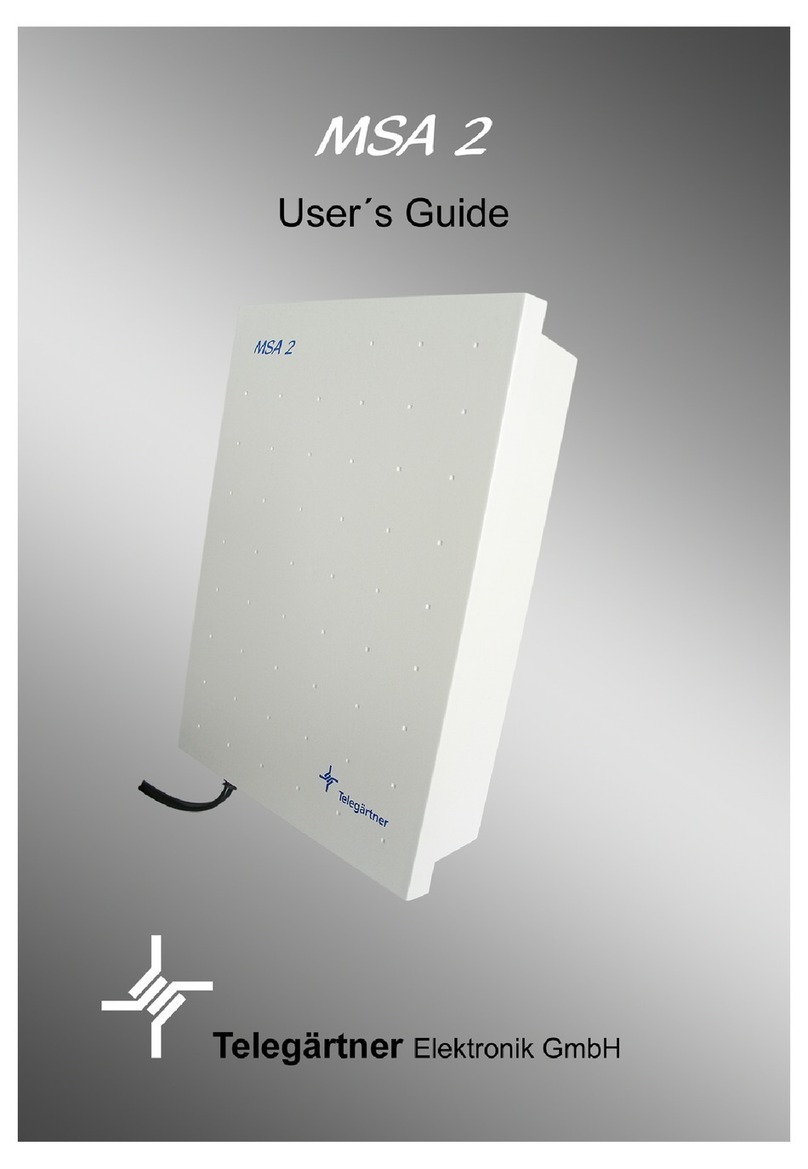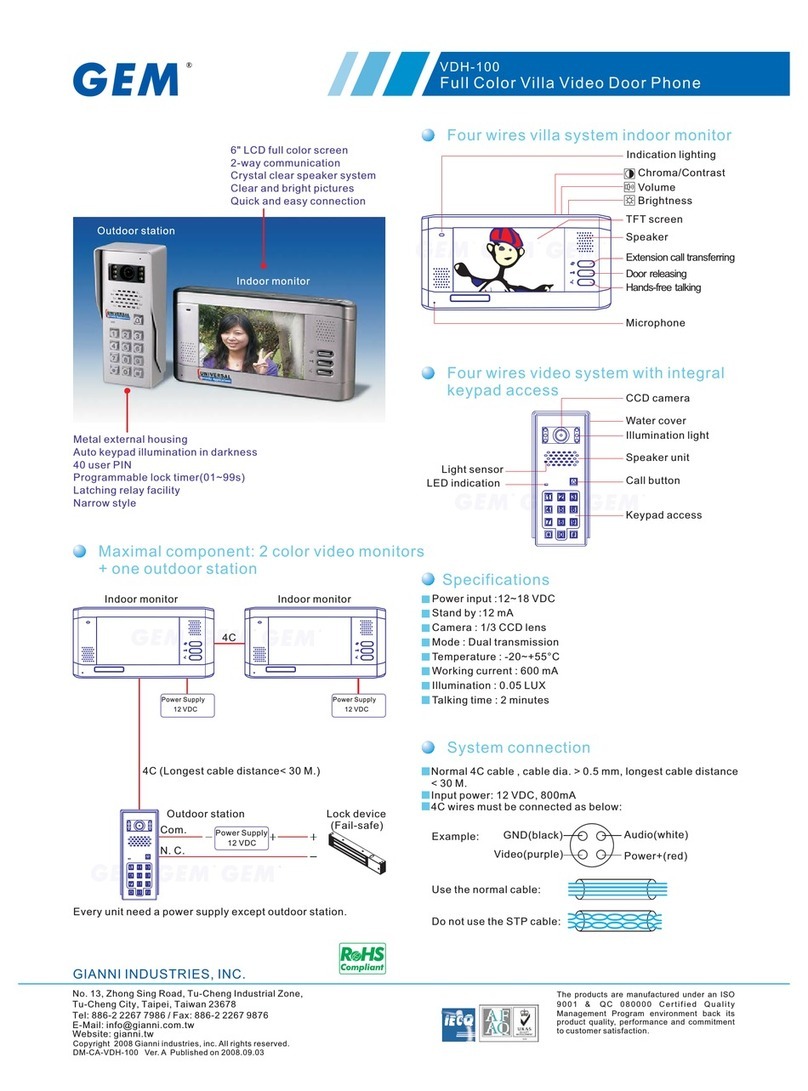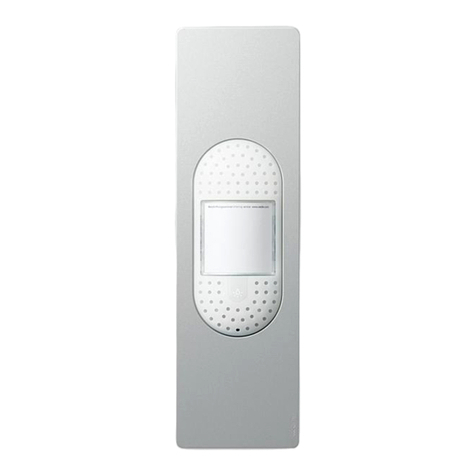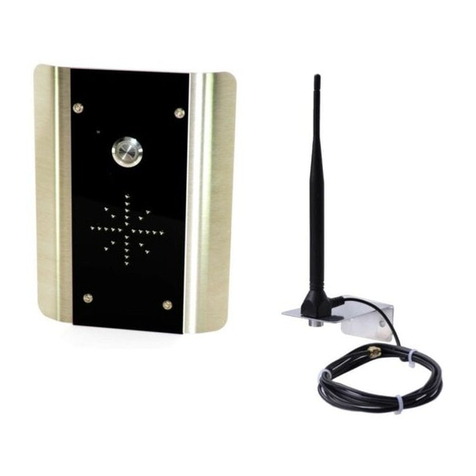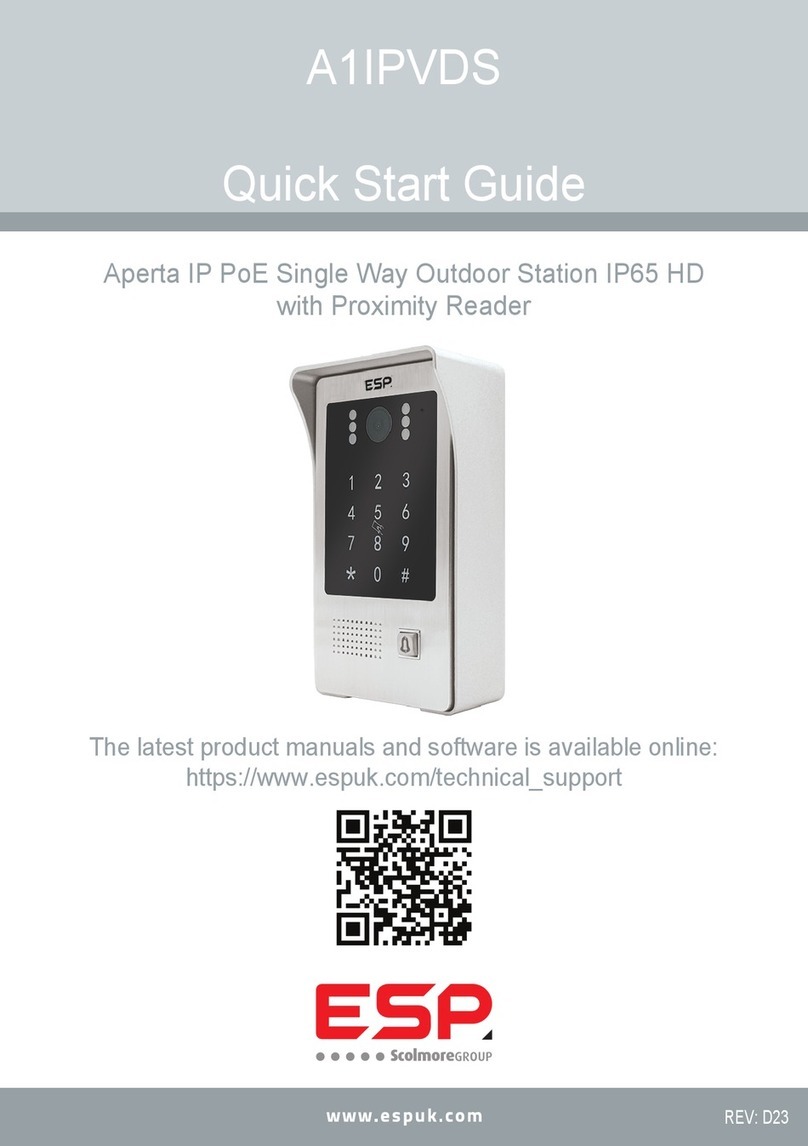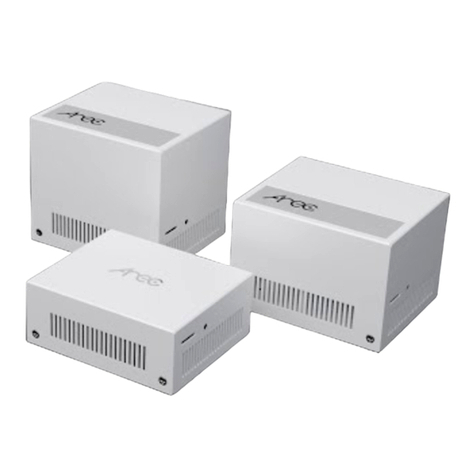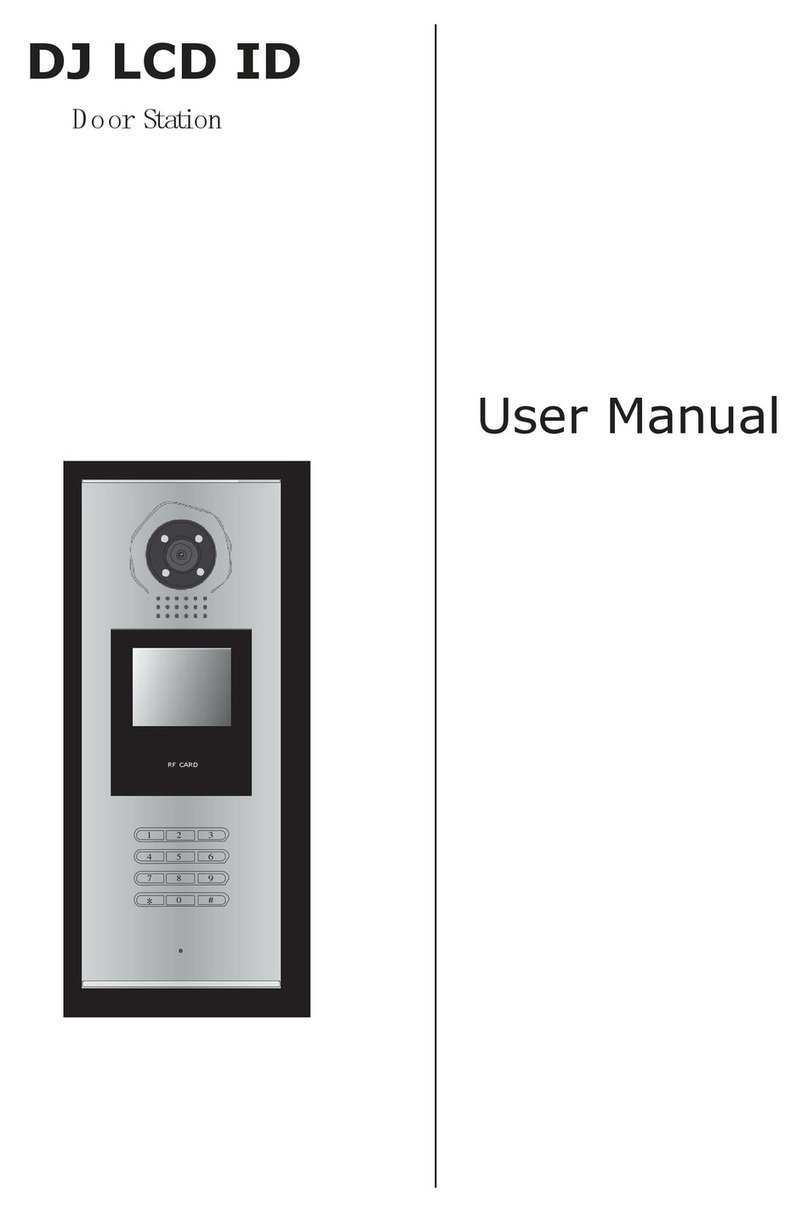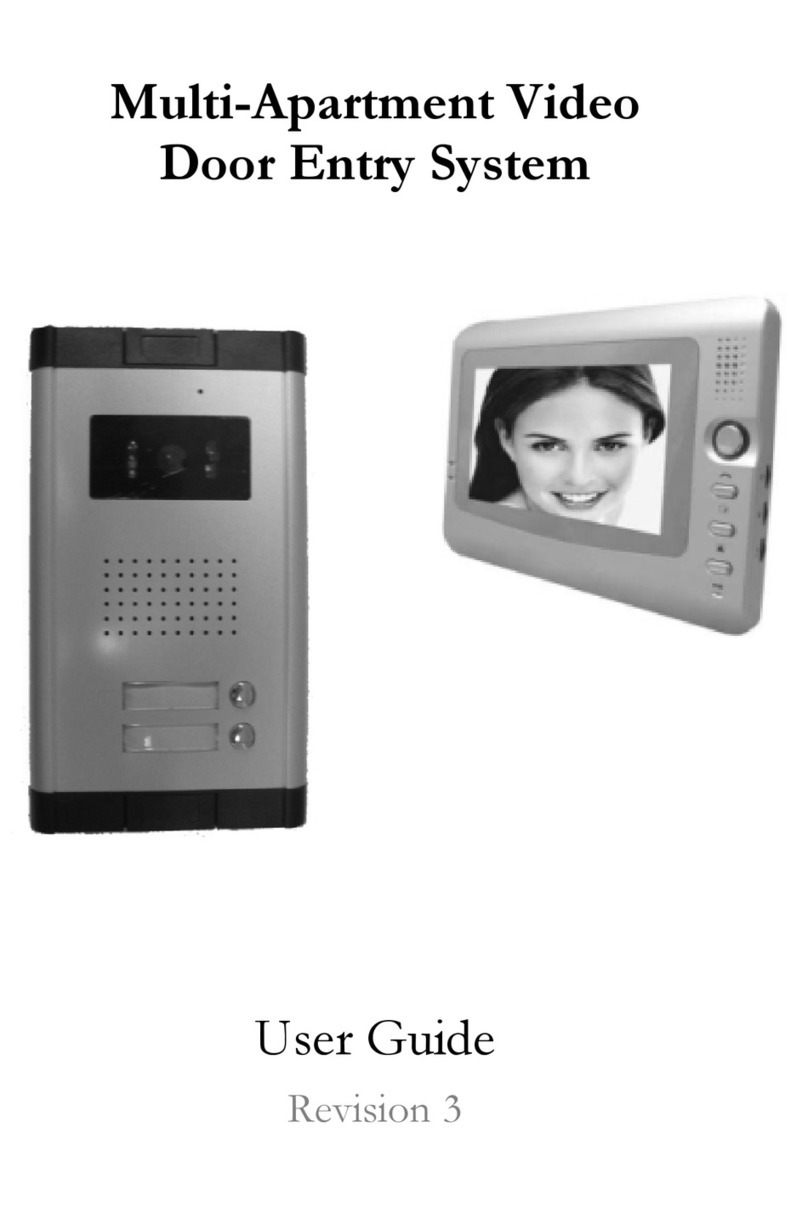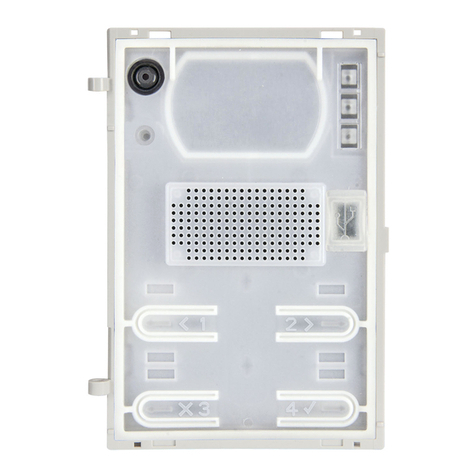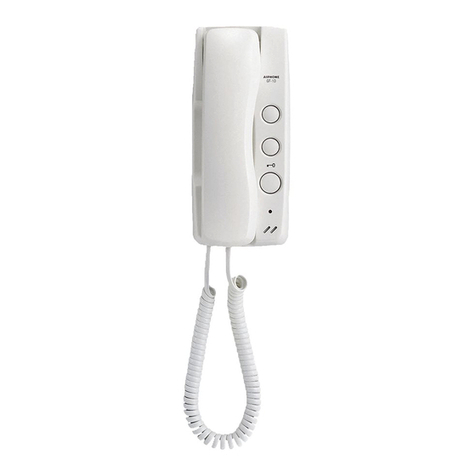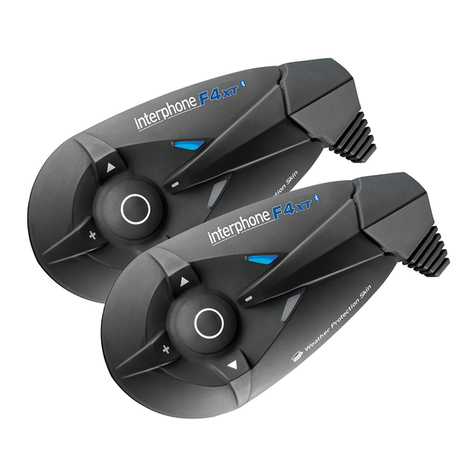Telegärtner DoorLine Slim DECT Product guide

Operating and Assembly Instructions
Door Intercom System
DoorLine Slim DECT

1Preface
2 / 56 DoorLine Slim DECT
1 Preface
Congratulations for purchasing the DoorLine Slim DECT from Telegärtner.
Read through these Operating Instructions carefully and attentively. They con-
tain important information for your safety and valuable tips and additional ap-
plication options of the device. The information on usage and care should
guarantee that you have many years of satisfaction with our product. Please
retain all documents, also for subsequent owners.
The content of these Operating Instructions has been prepared with great
care. In spite of all checks, however, there is still a possibility that technical in-
accuracies and typographical errors have been overlooked. All errors that
come to our notice shall be eliminated in new editions. We highly appreciate
your feedback at any time if you find a mistake that we overlooked.
These Operating Instructions also use the term "device" to refer to the DoorLine
Slim DECT.
The private branch exchange system is also referred to as "PBX System". The
private branch exchange system is possibly a function of your router (Fritz!Box,
Speedport, etc.) or your base station.
1.1 Copyright
Copyright 2019 Telegärtner Elektronik GmbH
Hofäckerstraße 18
74564 Crailsheim
We reserve all rights to this documentation, particularly in the case of patent or
utility model applications. The documentation, or parts thereof, must not be
altered manually, or in any other manner, without the express written authorisa-
tion from us, nor translated into any other language or computer language of
any form and by any means. This applies to electronic, mechanical, optical,
chemical and all other media. Product designations and company names
used in this documentation are subject to the rights of the companies in ques-
tion.

Table of contents
DoorLine Slim DECT 3 / 56
Table of contents
1 Preface...................................................................................................................2
1.1 Copyright ................................................................................................... 2
2 Safety instructions .................................................................................................6
3 Product information and description ..................................................................7
3.1 Model variants........................................................................................... 8
3.2 Nameplate................................................................................................. 8
3.3 Specified use .............................................................................................9
3.3.1 Notes on the use of an electronic door opener .................................... 9
3.4 Technical prerequisites........................................................................... 10
3.5 Technical data......................................................................................... 10
3.6 Accessories.............................................................................................. 11
4 Assembly and connection.................................................................................12
4.1 For your safety .........................................................................................12
4.2 Scope of supply....................................................................................... 12
4.3 Prior to assembly ..................................................................................... 12
4.4 Place of installation................................................................................. 13
4.5 Installing device ...................................................................................... 13
4.5.1 Installing mounting plate on the wall .................................................... 13
4.5.2 Installing device on mounting plate...................................................... 14
4.6 Connecting device................................................................................. 15
4.6.1 Important notes........................................................................................ 15
4.6.2 Wiring......................................................................................................... 16
4.6.3 Terminal assignment ................................................................................ 17
4.6.4 Wiring diagram......................................................................................... 18
4.6.5 Connection example for a door opener and a door bell.................. 19
4.6.6 DoorLine registration................................................................................ 20
4.6.7 Checking connection ............................................................................. 21
4.6.8 Check of DECT signal strength ............................................................... 21
4.7 Labelling bell pushbuttons ..................................................................... 22
5 Configuration.......................................................................................................24
5.1 Factory settings........................................................................................ 24
5.2 Restoring factory settings .......................................................................24
5.3 Acknowledgement tones....................................................................... 25
5.4 Saving and ending configuration.......................................................... 25
5.5 Entry to configuration mode .................................................................. 25
5.6 Defining microphone sensitivity and volume....................................... 26

Table of contents
4 / 56 DoorLine Slim DECT
5.7 Change the PIN Code ............................................................................27
5.8 Call numbers for bell pushbuttons......................................................... 28
5.8.1 Defining call numbers for bell pushbuttons........................................... 28
5.8.2 Deleting call numbers.............................................................................. 29
5.9 Enabling door opener function.............................................................. 30
5.10 Defining door opener time ..................................................................... 30
5.11 Defining call duration.............................................................................. 32
5.12 Defining call duration to extension line ................................................ 33
5.13 Call mode ................................................................................................33
5.13.1 Mute connection setup with call reception by button redial ............ 33
5.13.2 Connection setup with tone output ...................................................... 34
5.13.3 Mute connection setup........................................................................... 34
5.14 Defining absence numbers.................................................................... 35
5.14.1 Defining call numbers for call forwarding ............................................. 35
5.14.2 Deleting call numbers for call forwarding............................................. 36
5.15 Configuring relay contacts .................................................................... 36
5.15.1 Configuration of relay contact 1 ........................................................... 37
5.15.2 Configuration of relay contact 2 ........................................................... 38
6 Configuration of SwitchBox ................................................................................39
6.1 Registering SwitchBox............................................................................. 39
6.2 Defining PIN Code for SwitchBox ........................................................... 39
6.3 Configuring SwitchBox relay contacts .................................................. 40
6.3.1 Configuring SwitchBox relay contact 1 ................................................. 41
6.3.2 Configuring SwitchBox relay contact 2 ................................................. 42
6.3.3 Configuring SwitchBox relay contact 3 ................................................. 43
7 Overview of programming table.......................................................................44
8 Everyday use .......................................................................................................47
8.1 Receiving a door call .............................................................................47
8.2 Opening a door....................................................................................... 48
8.3 Calling the DoorLine................................................................................ 49
8.4 Activating / deactivating call forwarding to absence number ......... 50
8.5 Direct commands during voice communication ................................ 52
9 Malfunctions and fault elimination....................................................................53

Table of contents
DoorLine Slim DECT 5 / 56
10 Maintenance, care and disposal......................................................................54
10.1 Cleaning................................................................................................... 54
10.2 Storage ..................................................................................................... 54
10.3 Disassembly ............................................................................................. 54
10.4 Disposal .................................................................................................... 54
10.4.1 Disposing of packaging material........................................................... 54
10.4.2 Disposing of old device........................................................................... 54

2Safety instructions
6 / 56 DoorLine Slim DECT
2 Safety instructions
Before installing or using the product, it is essential to observe the instructions in
this manual.
If you fail to follow these instructions, the manufacturer Telegärtner Elektronik
GmbH will not accept any liability for any damage resulting from negligent or
deliberate disregard of the instructions in this operating manual!
▪ Keep small parts and packaging well away from children. There is a danger
of suffocation.
▪ Connect the product only to equipment that supplies SELV (Safety Extra
Low Voltage).
▪ Only connect CE-certified end devices to the telephone system.
▪ Do not connect devices that have equipotential bonding including earth-
ing on the lines.
▪ Do not use damaged devices. Have a damaged device repaired immedi-
ately.
▪ The lines must not be installed or connected during storms. Nor is it permit-
ted to insert or unplug the connection plug during storms.
▪ The housing must not be opened under any circumstances. Unauthorised
opening, incorrect repairs or modification can result in dangers to the user.
Warranty claims shall also be rendered void.
▪ Protect the product against dust, aggressive liquids and vapours.
▪ Do not use the product in damp rooms or in potentially explosive areas.
▪ Do not install your product near heat sources or other electrical devices.
▪ Do not permit liquid to penetrate the interior of the product. This may result
in electric shock or short-circuits.
▪ Route connecting lines and cables such that there is no risk of accidents!
▪ The DoorLine Slim DECT contains a radio module based on the DECT stand-
ard. The operation of medical devices may be impaired. Note the tech-
nical conditions of the respective environment, e.g. medical practice.

Product information and description 3
DoorLine Slim DECT 7 / 56
3 Product information and description
Fig.1:
Item Description
1 Bell pushbutton 1 (capacitance)
2 Bell pushbutton 2 (capacitance)
3 Brightness sensor
4 Microphone
5 Labelling panel
6 Loudspeaker (not visible)

3Product information and description
8 / 56 DoorLine Slim DECT
3.1 Model variants
DoorLine Slim DECT
Surface Glass
Colour/Article number white 150720
black 150730
3.2 Nameplate
The nameplate contains the serial number, product coding and information on
the device type.

Product information and description 3
DoorLine Slim DECT 9 / 56
3.3 Specified use
The DoorLine is designed for connection to DECT-compatible PBX systems.
It can be used
▪ as an intercom
▪ for remote-controlled opening of doors or gates
▪ for relaying door conversations to telephones
▪ for connection to other control systems
DoorLine has been developed for private as well as commercial use.
3.3.1 Notes on the use of an electronic door opener
There is an increased risk of burglary if you connect a door opener if the relay
contacts are accessible following disassembly of the DoorLine.
It is safer to configure a door opener via a SwitchBox (accessories) because this
is located inside the house, which means that the relay contacts cannot be
manipulated from the outside.
An electric door opener does not substitute door closure by a locking bar, it is
an intelligent, additional safety feature.
It is primarily intended for daytime operation, whereas at night time or in case
of absence the relevant door is locked by the locking bar.
As far as insurance is concerned, a door that is held closed only by the use of
the door opener is not regarded as locked!

3Product information and description
10 / 56 DoorLine Slim DECT
3.4 Technical prerequisites
▪ The DoorLine is designed for connection to DECT-compatible PBX systems.
▪ Both relay switching outputs of the device connect potential-free. This
means that when a door opener or a similar device is activated, it may be
necessary to provide an additional bell transformer (see chapterConnect-
ing device [}15]).
▪ Your PBX system and end devices (telephones) must support touch-tone di-
alling (DTMF).
▪ The DoorLine is not suitable for complete surface mounting. We recom-
mend assembly on a standard in-wall socket.
3.5 Technical data
Connection to
the base
Radio standard
frequency range
Range inside the
building
Range outdoors
DECT / GAP-compatible
1881 - 1897 MHz
up to 40 m
up to 300 m
Bell pushbuttons Number 2
Call numbers Number per button 2call numbers with
max. 20positions
Relay switching
outputs
Relay switching output 1
Relay switching output 2
potential-free, 24VAC / DC1A
potential-free, 24VAC / DC1A
General data Power supply
Cable length for power
supply
Current consumption
Degree of protection
Operating temperature
Weight
12 V/12 W, controlled
max. 10m
Standby 1W
Call state max.3.5W
IP54 (in installed state)
-20°C to +60°C
500g
Dimensions Mounting plate
Device
176x79mm
220x85x21mm

Product information and description 3
DoorLine Slim DECT 11 / 56
3.6 Accessories
▪ Wall power supply SNG DL article number 105248
(For use as bell transformer, door opener current supply, etc. Cannot be
used for power supply to the DoorLine Slim DECT!)
▪ Power unit for carrier rail assembly (DIN rail), article number 114651
(For power supply to the DoorLine Slim DECT)
▪ SwitchBox SB-442 article number 151003
Surface mounting or assembly on carrier rail (DIN rail)
– 4 PBX system connectable
(only in conjunction with DoorLine Slim and DoorLine Pro Exclusive)
– Extends the DoorLine Slim DECT by three further relay contacts

4Assembly and connection
12 / 56 DoorLine Slim DECT
4 Assembly and connection
4.1 For your safety
Assembly must only be carried out by specialists with corresponding skills and
experience. These persons must be able to detect dangers and to avoid pos-
sible risks.
The statutory specifications at the place of installation must be observed.
Take care not to jam the connecting cables during installation.
Also observe the safety instructions at the start of the Operating Instructions.
Caution: The front panel of the device is made of glass. It can be damaged
and cause injury. Protect the glass surfaces against damage.
4.2 Scope of supply
The scope of supply of the device includes:
▪ the device
▪ Assembly and Operating Instructions
▪ mounting plate
▪ sealing flange
▪ bag with fastening material and Allen key
▪ wall power supply
4.3 Prior to assembly
Check all parts for completeness and transport damage prior to assembly.
We recommend that you initially register the DoorLine in the direct vicinity of
your PBX system, try it out and make the basic configuration.
In this manner, you can install the wiring and configure the bell pushbutton
quickly and easily.
After the DoorLine functions perfectly in this test setup with your TC system and
telephones, you can install the DoorLine in its final place of usage.

Assembly and connection 4
DoorLine Slim DECT 13 / 56
4.4 Place of installation
▪ The device is intended for installation outdoors in an area protected from
splash water (moisture protection as per IP 54, splash water at an angle of
up to 60° to the verticals).
▪ A minimum distance from the microphone to the nearest corner wall sur-
face of at least 10cm must be observed.
▪ The ambient temperature must be between -20°C and +60°C.
▪ In the area of the installation location, no supply lines or similarmust be in-
stalled.
4.5 Installing device
The device is installed on a standard in-wall socket or a corresponding cavity
be means of the enclosed mounting plate and fastening material.
4.5.1 Installing mounting plate on the wall
Fig.2:

4Assembly and connection
14 / 56 DoorLine Slim DECT
1. Position the mounting plate (1) on a standard in-wall socket(2) or a suitable
cavity in the masonry. The recess in the mounting plate must be fitted ac-
curately on the in-wall socket.
2. Ensure that no supply lines, cables or similar are installed in the area of the
drilling holes(3).
3. Fasten the mounting plate via the two boreholes(3) onto the wall with
screwsand dowels.
4. Press the sealing flange (4) into the recess on the mounting plate(1).
4.5.2 Installing device on mounting plate
Fig.3:
1. Connect the terminals(1) (see chapter Connecting device [}15]).
2. Insert the terminals (1) back into the device.
3. Place the device diagonally from above onto the mounting plate until the
four metal lugs(2) engage in the four fastening holes of the device.
4. Secure the device with the hexagon socket-grub screw(3) on the mounting
plate.
Caution: Only tighten the screw lightly because otherwise the thread can
be damaged.

Assembly and connection 4
DoorLine Slim DECT 15 / 56
4.6 Connecting device
4.6.1 Important notes
▪ Before connecting the device to the PBX system, switch off all required
components and those connected to the DoorLine (bell transformer, power
unit).
▪ When installing the wiring, ensure that the polarity (12V DC voltage) of the
two wires in the terminals is correct.
▪ Do not insert the wall power supply into the socket until all wires are firmly
connected and there is no risk of a short circuit of wire pairs.
▪ A bell transformer (e.g.12 V alternating voltage) must not be used as a
power supply for the device. This can result in destruction of the device!
▪ Both integrated relay contacts connect potential-free, i.ean additional bell
transformer is required to activate a door opener. Then connect the bell
transformer voltage via the respective relay switching output to the door
opener (see chapter Connection example for a door opener and a door
bell [}19]).
▪ Both switching relays can be loaded to a max. of 24VAC/DC1 A. Prior to
initial operation of the device, ensure that these values are not exceeded
by your door opener, door bell or other devices to be connected. Observe
the Operating Instructions of the respective products.

4Assembly and connection
16 / 56 DoorLine Slim DECT
4.6.2 Wiring
For the installation wiring of the relay contacts, SwitchBox and power supply of
the device, use commercially available telecommunication cables.
Please note that in order to meet general safety provision and to avoid interfer-
ence influences, the low-current lines must be routed separately from power
lines.
Observe a minimum distance of 10 cm between both types of lines. If one of
the connected lines is routed out-of-doors, you will have to provide sufficient
lightning protection.
Lines types that can be used
▪ Telecommunication indoor cable
– J-Y(ST)-Y 2 x 2 x 0.6
– J-Y(ST)-Y 2 x 2 x 0.8
– J-Y(ST)-Y 4 x 2 x 0.6
– J-Y(ST)-Y 4 x 2 x 0.8
▪ Bell sheathed cable
– YR 4 x 0.8
▪ Telecommunications cable
– A-2Y(L)2Y 4 x 2 x 0.8
Maximum cable lengths for connection to door opener
Wire diameter 0.8 mm 0.6 mm
Ranges for door opener operation from an ex-
ternal bell transformer to door opener (max-
imum current consumption 1A alternating
voltage)
12 V
16 V
20 V
24 V
38 m
76 m
115 m
177 m
17 m
34 m
51 m
78 m

Assembly and connection 4
DoorLine Slim DECT 17 / 56
4.6.3 Terminal assignment
The rear side of the device has two screw-in/terminal plug-in connectors. They
can be unplugged for convenient connection of the lines.
Labelling is on the rear side of the housing.
View from the rear View of terminals
1 Supply voltage +12V 7 SwitchBox data
2 Supply voltage GND 8 SwitchBox -
3 Relay contact 2
potential-free
9 SwitchBox +
4 Relay contact 2
potential-free
10 not assigned
5 Relay contact 1
potential-free
11 not assigned
6 Relay contact 1
potential-free

4Assembly and connection
18 / 56 DoorLine Slim DECT
4.6.4 Wiring diagram
Fig.4:
Item Description
A DoorLine (rear side)
B Wall power supply
C DECT-compatible PBX system
D SwitchBox
E Relay contact 2
F Relay contact 1

Assembly and connection 4
DoorLine Slim DECT 19 / 56
4.6.5 Connection example for a door opener
and a door bell
Item Description
A DoorLine (rear side)
B Wall power supply
G Door bell to relay contact 1
H Door opener to relay contact 2
I Bell transformer

4Assembly and connection
20 / 56 DoorLine Slim DECT
4.6.6 DoorLine registration
Note: The DoorLine permits registration to a PBX system only during the first
15minutes after application of the power supply. Readiness for registration can
be activated again for 15minutes at any time by briefly interrupting the
voltage supply.
The DECT-PIN of the DoorLine cannot be changed and is permanently set to
0000. If a different DECT PIN is configured on your PBX system, it must be
changed prior to registration to 0000.
Important: The DECT-PIN is not the PIN code for configuration of the DoorLine
Slim DECT.
Further information on changing the DECT-PIN is available in the Operating In-
structions of your PBX system.
The DoorLine remains for up to 2 minutes in registration mode. If you
have to cover a long distance to reach your PBX system, first change
the DoorLine to registration mode. The time required can vary accord-
ing to the PBX system.
1. Apply the voltage supply.
ðThe DoorLine starts up. If the surrounding area is dark, the DoorLine light-
ing switches on.
2. Switch your PBX system to registration mode.
3. Actuate both bell pushbuttons for 5 seconds.
ðPress both buttons at the same time because otherwise normal ringing of
the bell will be detected.
ðWhen the button is pressed, a double acknowledgement tone sounds
immediately.
ðAfter 5 seconds, a single acknowledgement tone sounds. The buttons
can now be released. The DoorLine registers at the base which is now
ready for registration.
4. After successful registration, a double acknowledgement tone sounds.
ðYour PBX system assigns a new internal call number for the DoorLine. The
DoorLine can now be reached and can call under this call number.
ðIf registration is unsuccessful, a negative acknowledgement tone sounds
(eight short beeps in succession). Registration could not be carried out
successfully and has to be restarted.
Table of contents
Other Telegärtner Intercom System manuals
